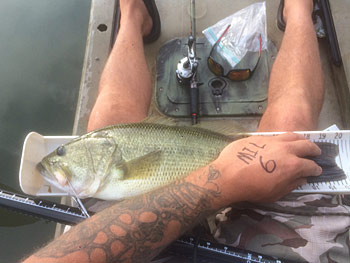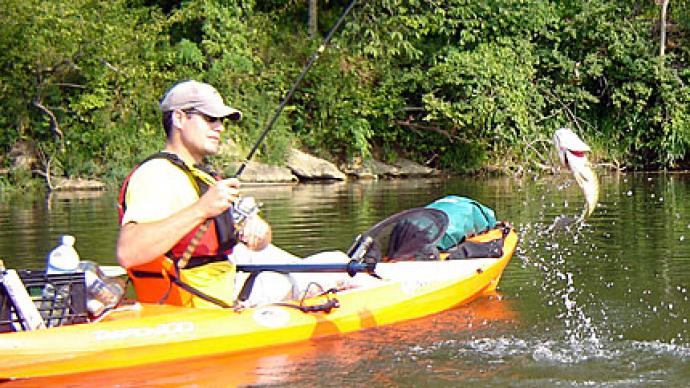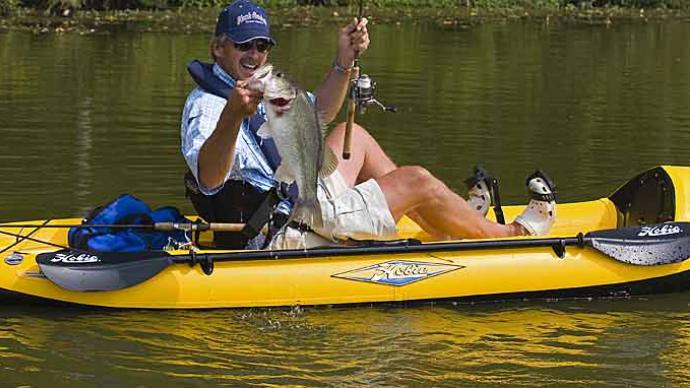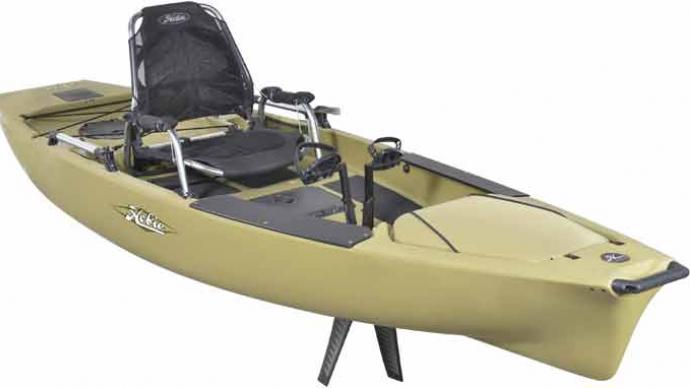
Nothing makes up an angler’s mind faster than a big bass. The lure that caught it instantly becomes a most-prized possession, and the lake that produced it is the world’s best, at least in the eyes of the angler doing the catching. A big bass caught by North Carolina bass angler Joey Randall made him realize that fishing from a kayak was the way to go for him.
It was a cloudy and rainy day during a little warm spell in late February 2017 when Randall hopped in a kayak for the first time. He was just across the state line in South Carolina, not too far from his home outside Charlotte, fishing a small pond. It was perfect conditions for spinnerbaits, so he was throwing a ½-ounce model, slow rolling it along the bottom. “She ate the blades and everything and did two little runs before coming straight to the boat,” he said. The 11 ½-pound largemouth wasn’t his first bass of that day. That one weighed 5 pounds.
If you’ve spent any time in a boat over the past decade, there’s no doubt that you’ve seen more kayaks. Some are paddled by people simply enjoying a day on the water. But others carry bass anglers casting and catching as they glide along. Maybe you’ve thought about fishing from a kayak. If so, you aren’t alone.
Randall isn’t a rookie. He has fished from a bass boat, winning several 20- to 25-boat tournaments on Lake Norman, the largest body of water in North Carolina. But his fishing changed when he climbed in a kayak. There are plenty of experiences, tactics, and gear that you can bring to kayak fishing from boat fishing. But kayaks offer their advantages, along with a few challenges. Here’s what you need to know to make the switch.
Randall said the kayak had added excitement to his fishing trips. Much of that is a result of its ability to help him catch bass — and big ones to boot — that other anglers are missing. The most significant advantage that kayaks have over boats is the small profile.
“The main thing I’ve learned for kayak fishing is a stealth mode,” Randall said. “You’re sneaking in and taking it easy. If a big bass is in there, you stand a better chance of catching it [from a kayak].” Big bass have been around long enough to have seen plenty of lures thrown their way. They always seem to know when something isn’t right. “If you want to catch him, you have to sneak up on him,” he said.
The thud of a dropping trolling motor or a closing compartment lid can give big bass an advance heads up. Many times anglers don’t realize they are doing that. It happened to Randall. The motor vibrated slightly when the trolling-motor mount on his boat was broken. Once he fixed it, he caught more bass.

Without compartments and trolling motors, kayak anglers present a quieter approach that doesn’t intimidate bass. While fishing the clear water of Lake Wylie, Norman’s downstream Catawba River neighbor, Randall, had a 6-pounder engulf his buzzbait less than 10 feet from his rod tip. “I’ve never had one eat that close to me,” he said.
A kayak’s small profile is a benefit in other ways. Randall watched an angler pull his bass boat over a deep point strewn with rocks. While he hung back and watched the scene unfold, the angler stared at his electronics and fished the bottom without a bite. After he left, Randall paddled over, and on his first cast, he caught a big spotted bass on a shakey head. He believes the bass could feel the bigger boat’s presence through their lateral line, which spooked them to the bottom. They said they didn’t notice his kayak and swam up to feed.
Randall said kayaks could take you places bigger boats can’t go, including small lakes, ponds, and rivers. But they also open doors on larger bodies of water, primarily where waterside residents use walkways to reach their floating docks.
When bass are on the shallowest portion of those docks, such as during the spawn, anglers fishing from boats must go around each dock to reach the next stretch of bank. On the other hand, Randall paddles his kayak under the walkways, remaining where the bass are and adding to his fishing time. He does make one change to make that happen. Instead of storing his rods in holders that point them 45 to 90 degrees above the water, as many kayak anglers do, he lays them down, like on a boat.
Without a rod locker and minimal deck space, Randall’s kayak doesn’t have space for a full quiver of rods. So he must bring ones that serve several roles. “It might not be the best for that technique,” he said. Those rods make room for one or two technique-specific outfits, which he brings when the situation arises. When he fishes South Carolina’s Lake Wateree, the last lake on the Catawba River and about 45 minutes south of Charlotte, for example, he packs a flipping stick to pluck bass from its plentiful emergent aquatic grass.
Randall has started throwing topwater lures, including walking baits, poppers, and prop baits, on the spinning rod he uses for shakey heads. He ties them directly to the braided line. When the topwater bite dies, he cuts off that lure and ties on a fluorocarbon leader, which he has pre-tied to a shakey head. And with that one simple knot, he’s ready to fish deeper water.
The switch to braided line for topwaters has provided a second benefit — better hooksets. Randall long threw topwaters with monofilament line. Its stretch helped keep bass from throwing treble hooks and created a momentary delay on the hook set, giving them more time to grab the lure. Even experienced anglers like Randall have a hard time waiting to feel a bass grab a topwater lure and not set on the splash it makes. That’s not an issue in a relatively stationary boat. “[But] the moment you set the hook in a kayak, you’re moving,” he said. So with monofilament, your hookset may move your kayak rather than the bass. Braided line, which has no stretch, will move the hooks on a hook set, even if you move.

Randall has scaled down his tackle selection, too. Instead of compartments filled with bags of soft-plastic lures and utility boxes of hard baits, he puts everything in an old-school three-tray Flambeau tackle box. He fills it with his favorites, as you would imagine. But he makes sure what he does have covers a range of situations. “If they aren’t hitting moving baits, I’ll pick up a shakey head and not put it down,” he said.
Some lures create enough water resistance that they pull the kayak toward them. Randall said you'll lose some casting distance when you fish such a lure, including spinnerbaits with large Colorado blades and crankbaits. But that’s not a reason to stop using them. “It’s manageable,” he said.
A similar situation comes into play while fighting bass. “The fish has you almost as you have it in a kayak,” Randall said. He said you have to let them play out, and you’ll lose most that you try to horse. He speaks from experience. He solidly hooked one three ½-pound bass in its nose with a shakey head. While trying to crank it in, the bass jumped, bounced off the kayak, and shook the hook. That fish also is why he recommends that you carry a landing net.
Fishing from a kayak takes physical work, especially when ready to try a new spot. Moving isn’t as simple as turning the ignition key. Instead, you have to pick up your paddle and start digging. That’s easier done in short and narrow kayaks. But they are tippy, like a boat with a narrow beam, making fishing more challenging.
You’ll find plenty of stability in wider kayaks, Randall said. His measures almost 13 feet, and its wide beam means he can stand and fish. But that comes with a sacrifice: They don’t move through the water as easily. So he has to exert more effort when paddling. And no matter how hard he paddles — he was “dead tired” after paddling and fishing 4 miles — it has never been faster than narrower kayaks. But that’s changing.
Most kayak manufacturers have introduced pedal-drive models in recent years. They have bicycle pedals for your feet that drive flippers or propellers. “Those guys can run 6 or 7 miles per hour and cover 10 or 12 miles, no problem,” Randall said. Covering more water opens more opportunities to catch bass. The new technology also changes offshore fishing. Instead of managing the paddle and fishing rod, which can be frustrating, especially while trying to hold on to a spot while the wind is blowing, he said you can pedal and fish simultaneously.
Added maneuverability will continue to play a role in kayak bass tournaments, whose popularity is skyrocketing. They operate slightly differently than boat tournaments. Without access to a livewell, anglers use their smartphones to photograph each of their catches on a measuring board and next to an identifier, such as a code or playing card, which links them to the angler and day. Later a judge examines all the photos, ruling on the length of each bass. The winner has the most inches. In the Charlotte-based Queen City Kayak Bass Fishing’s tournaments that Randall regularly fishes, the winner usually presents a four-bass limit that measures 65 to 70 inches, which is a 16- to 18-inch average.
Despite missing the Queen City Kayak Bass Fishing’s first tournament of 2017, Randall has managed a check in all of its other contests. While that’s nice, he said the new challenge of competing from a kayak hooked him. “It’s still fishing, and you still want to win,” Randall said. “You still have to catch them.




